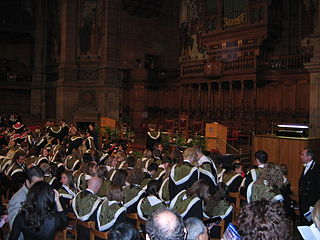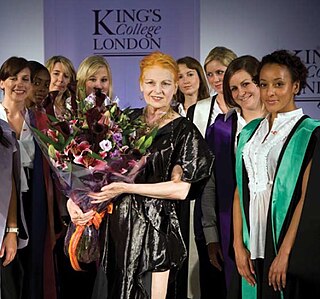 W
WThe academic regalia of Columbia University are the robes, gowns, and hoods which are prescribed by the university for its graduates. As one of the oldest universities in the United States, Columbia University has a long tradition of academic dress dating back to its founding in the 18th century. The development of Columbia's academic regalia has strongly influenced those of most universities in the United States. Though once worn daily by students at the university, caps and gowns now are only worn during commencement.
 W
WThe University of Cambridge has a long tradition of academic dress, which it traditionally refers to as academical dress. Almost every degree which is awarded by the university has its own distinct gown in addition to having its own hood. Undergraduates wear college gowns which have subtle differences enabling the wearer's college to be determined. Academic dress is worn quite often in Cambridge on formal, and sometimes informal, occasions, and there are a number of rules and customs governing when and how it is worn. Black gowns (undress) are worn at less formal events, while on special days full academical dress is worn, consisting of gown, hood and headdress with Doctors in festal dress. The university's officials also have ancient forms of academic dress, unique to the university.
 W
WThe Academic dress of Chulalongkorn University is a long-sleeved gown made from light mesh, faced and bordered with a specially designed felt strip. The same strip is also attached to elbows and wrists. The gown itself is adapted from ceremonial attire called suea khrui and was designed in Prajadhipok's reign, together with the existing academic badge.
 W
WAcademic dress prescribed at the University of Dublin and its sole constituent college, Trinity College, follows a relatively complex protocol which, nonetheless, shares some particular characteristics with other universities in Ireland and with the University of Oxford in the United Kingdom.
 W
WThe academic dress of Durham University has many similarities with that of other older British universities such as Oxford and Cambridge. Most colleges of Durham University insist on gowns being worn on formal occasions, including matriculation and formal halls (dinners); exceptions are Van Mildert, St Cuthbert's Society, Collingwood, Stephenson, St Aidans, and The College of St Hild and St Bede. Some colleges also insist on their being worn to Junior Common Room meetings, and they are often seen in college chapels. At formal halls, only gowns are worn and doctors normally wear their undress gowns; for more ceremonial occasions full-dress gowns and hoods are worn by graduates. Until 1990, the General Regulations of university 'recommended' the wearing of gowns by members of the university when attending divine service at the Cathedral – but this is now left to individual choice apart from at certain services. Gowns are also customarily worn to meetings of the university Senate by members of that body.
 W
WAcademic dress at the University of Edinburgh is compulsory at official ceremonial occasions, such as graduation and the installations of Rector and Chancellor, and otherwise optional, usually only worn for events.
 W
WAs the oldest college in the United States, Harvard University has a long tradition of academic dress. Harvard gown facings bear crow's-feet emblems near the yoke, a symbol unique to Harvard, made from flat braid in colours distinctive of the wearer's qualification or degree. Crow's-feet are double for earned degrees, and triple for honorary degrees.
 W
WThe University of Hertfordshire (UOH) is a public university in Hertfordshire, United Kingdom. The university is based largely in Hatfield, Hertfordshire. Its antecedent institution, Hatfield Technical College, was founded in 1948 and was identified as one of 25 Colleges of Technology in the United Kingdom in 1959. In 1992, Hatfield Polytechnic was granted university status by the British government and subsequently renamed University of Hertfordshire. It is one of the post-1992 universities.
 W
WAcademic dress of Imperial College London describes the robes, gowns, and hoods worn by graduates and associates of Imperial College London. After gaining its independence from the University of London in 2007, graduates began wearing Imperial academic dress in 2008. The unifying colour for Imperial's academic dress is purple after the work by William Henry Perkin.
 W
WAcademic dress of King's College London describes the robes, gowns, and hoods worn by undergraduates, graduates and associates of King's College London. After being vested the power to award its own degrees from the University of London in 2006, graduates began wearing King's College London academic dress in 2008.
 W
WAcademic dress of the University of Manchester describes the gowns, hoods and headwear which are prescribed by the university for its graduates and officers.
 W
WThe academic dress of McGill University describes the caps, gowns and hoods which are prescribed by the university for its degree candidates/holders. Until the mid-20th century, McGill also prescribed academic dress for its matriculating or enrolled students as well as its faculty. Founded in 1821, McGill University is consistently ranked as one of Canada's preeminent universities, and among the top 20 universities in the world.
 W
WThe academic dress of University of Melbourne describes the formal attire of robes, gowns and hoods prescribed by the Statutes and Regulations for undergraduates, graduates, officers and honorands of the university. This follows the Oxford style for the gowns and hoods for the Bachelors and Masters degrees. For its doctorates, Melbourne follows the style of Cambridge.
 W
WIn general, the academic dress of the University of Nottingham dates from the award of its Royal Charter in 1948. Prior to this date, University College, Nottingham taught students for University of London examinations and "Nottingham graduates" were actually London graduates and wore the appropriate dress. There was, however, a unique Nottingham undergraduate gown. This still exists but, like equivalent gowns at most other universities, is now very rarely seen.
 W
WThe University of Oxford has a long tradition of academic dress, which continues to the present day.
 W
WThe academic regalia of Stanford University describes the robes, gowns, and hoods which are prescribed by the university for its graduates. Stanford University was founded in 1891 and academic dress has been a part of academic life at the school since at least 1899. As in most American universities, the academic dress found at Stanford is derived from that of the universities of Oxford and Cambridge, which was a development of academic and clerical dress common throughout the medieval universities of Europe. Today, also in common with most American universities, academic regalia is commonly seen only at graduation ceremonies. For most of its academic dress, Stanford follows the Intercollegiate Code of Academic Costume which was devised in 1895 and sets out a detailed uniform scheme of academic regalia. Stanford does make use of a distinct robe for its PhD graduates which was unique among American institutions of higher education in being based specifically on the doctoral robes of the University of Cambridge.
 W
WUniversity of Wales, Lampeter was a university in Lampeter, Wales. Founded in 1822, and incorporated by royal charter in 1828, it was the oldest degree awarding institution in Wales, with limited degree awarding powers since 1852. It was a self-governing college of the University of Wales from 1972 until its merger with Trinity University College in 2010 to form the University of Wales Trinity Saint David.